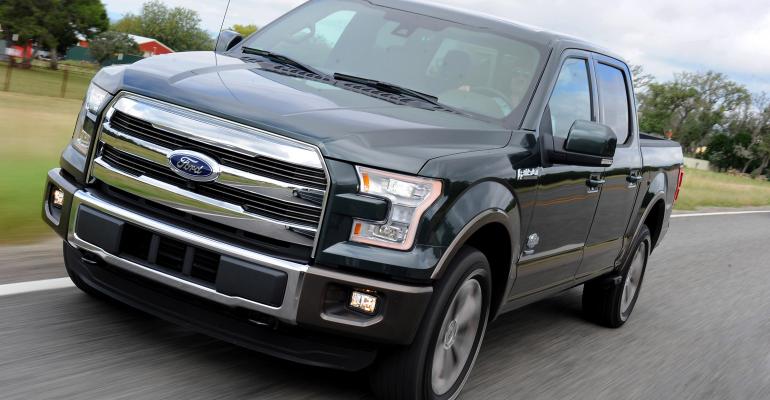SAN ANTONIO – Ford has high expectations for the all-new ’15 F-150 pickup. Among the goals are a gain in market share, a boost in average-transaction prices and successful conquesting of other brand’s buyers.
“We expect to gain market share – it goes without saying,” Doug Scott, F-150 marketing chief, tells WardsAuto during a test drive of the pickup here. “Last year, we had the best retail market share we’ve had since 1993. We’ve got a revolutionary new product, and I think it will be deserving of an increase in share.”
Ford last year held a 35.7% share of the U.S. fullsize-pickup segment, ahead of the Chevrolet Silverado’s 23.2% and the Ram 1500’s 17.8%, according to a WardsAuto estimate. Through September, the F-150 controlled 31.3% of the sector, while Silverado had a 28.7% share and Ram 18.8%.
Scott declines to reveal Ford targets, noting only that the innovative all-aluminum truck presents new opportunities.
Conquesting buyers in the fullsize-pickup segment is no easy task. Even Scott admits owners are among the most loyal in the industry. But he says it’s likely to happen, given the game-changing nature of the truck.
The new F-150 is nearly 700 lbs. (317 kg) lighter than its predecessor due to its aluminum structure. A new 2.7L EcoBoost V-6 is expected to achieve better fuel economy than most competitors, although official numbers have yet to be released. When combined, Scott says, those factors will be enough to draw conquest buyers.
“The whole handling dynamics of our truck is changing,” he says. “I think we have the best chance we ever had to conquest.”
Scott doesn’t expect to lose any share during the manufacturing transition from the outgoing F-150 to the new model. Ford’s Dearborn, MI, assembly plant is undergoing a changeover that is slated to be completed by mid- to late October. The Kansas City, MO, plant is scheduled to be overhauled next.
“We’re ahead of our sell-down pace, but we’ve got plenty of inventory, so we have enough inventory where we can manage our way through the transition to the new truck,” he says. “So we’re in a good position.”
Ford F-150 inventory at the end of September was 106 days’ supply, which Scott says is the highest level ever for the pickup.
Despite having the oldest truck in the segment, Scott says the F-150 has the highest ATPs among top competitors, including the Silverado and Ram 1500.
Erich Merkle, Ford’s top U.S. sales analyst, says the automaker has not had to rely on incentives to sell the F-150.
“The ATP is just over $40,000 per truck,” he says. “Year-over-year our incentive spend has been down. We’re trying to manage our inventories right now, because if our sales run too hot, we don’t have any way of replenishing old F-Series.”
When the ’15 F-150 goes on sale in the fourth quarter it will face new competition from the recently launched Chevrolet Colorado and GMC Canyon midsize pickups. Ford pulled the plug on its Ranger small pickup in 2011, citing a declining segment as the primary reason.
Scott says Ford data suggests customers are willing to pay a little extra for the capabilities of a fullsize pickup rather than opt for a slightly more affordable midsize truck. He also defends Ford’s decision to exit the sector, noting it continues to contract.
The segment “declines every year,” he says. “It went from about 1 million units to about 250,000 units last year, and it’s going to be lower this year,” he says.
Ford always has marketed the F-150 pickup heavily, particularly during sporting events, and that will not change with the ’15 model. Scott says the automaker will not shy away from touting the F-150’s aluminum structure, despite some criticism the material may not hold up as well as steel.
“Since we revealed the truck, we’ve been very open about the basis of our lightweight strategy,” he says. “Aluminum is the enabler, but it isn’t aluminum for aluminum sake. It’s lightweighting enabled by aluminum that produces a broad range of benefits that are important to the customer.”
Scott says Ford has provided training and equipment to 1,500 dealer and independent body shops that allows them to repair aluminum. In addition, he expects the F-150’s new structure to mitigate repair costs.
“We’ve made it more modular, so it takes less time for certain structural repairs, and you have to replace fewer parts, so that will reduce costs,” he says.





